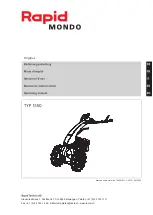
7
9.
TROUBLESHOOTING
WARNING
SERVICE SHOULD BE PERFORMED BY A
QUALIFIED TECHNICIAN. BEFORE
REPLACING ANY ELECTRICAL OR
MECHANICAL COMPONENTS, UNPLUG
THE LINE CORD. IF ELECTRICAL POWER
IS REQUIRED FOR SERVICE, USE
EXTREME CARE.
9.01
Refer to Troubleshooting Procedures Table
(9.03 through 9.06) for troubleshooting information
on the baths. This table provides the basic
information required to repair the bath.
9.02
The following is a list of the tools and
instruments required to perform the procedures
outlined in the Troubleshooting Procedures
table.
Tools Needed:
•
Phillips or Flat Head Screwdriver
•
Ohmmeter
•
DC Voltmeter
•
AC Voltmeter
•
5Vdc Power Supply
Trouble Shooting Procedures
1. Verify that setpoint temp is greater than the actual
water temp.
Problem
9.03 No Heat
2. Verify that Hi Limit lamp is off. If light is on, turn
High Limit control fully clockwise.
3. Check temperature probe.
A. Disconnect unit from electrical supply.
B. Disconnect temperature probe connector
J302 from CPU board.
C. Apply a +5VDC to the temperature probe, +5 to
pin 1 of blue connector. Ground to pin 3 of blue
connector. The connector has these numbers
embedded on it.
D. Place a voltmeter between pins 2 & 3 on
temperature probe connector. Place the temp-
erature probe in a bath of known temperature.
Verify that the output voltage of the
temperature probe approximately
corresponds to the values in the table
below.
Degrees Centigrade vs. Output Voltage of Temperature Probe
Temp
o
C
Volt
Temp
o
C
Volt
0
320mV
60
1.400V
10
500mV
70
1.580V
20
680mV
80
1.760V
30
860mV
90
1.940V
40
1.040V
99.9
2.218V
50
1.220V
E. If a 5V DC power supply is not available, leave J302
connected to the CPU board, turn power on and repeat
step
D by placing the voltmeter probes on the backside of J302.
Procedure









































